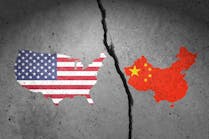A “Commons” and “Standards” approach to strengthen pandemic response
In November, the distinguished public policy journal The Milbank Quarterly published an online version of an article proposing a “commons-based” approach to shoring up access to critical supplies in the event of a national public health emergency, such as we are experiencing with COVID-19. I felt compelled to feature the article in this month’s edition of Standard Practices for two reasons. First, the authors, including well-known supply chain professors Gene Schneller and Rob Handfield, provide important insights into a breadth of root causes behind our inability to meet heightened demand for critical supplies during this pandemic, along with recommendations to better prepare for future emergencies by leveraging the respective capabilities of the public and private sector. Second, I wanted to comment on some of the discussions related to the use of standard identifiers and barcode technology to achieve their vision.
The article, entitled “A Commons for a Supply Chain in the Post-COVID-19 Era,“ responds in part to a legislative mandate in the CARES Act (H.R. 748) that calls for the National Academies of Sciences, Engineering, and Medicine to make recommendations to address “supply chain vulnerabilities or potential disruptions of products that would significantly affect or pose a threat to public health security or national security.” The authors conclude that the U.S needs what it calls a “commons-based strategy” that goes beyond a Strategic National Stockpile to include a network of product repositories, active inventory management, and analytics and dashboards to monitor supply and demand.
Drawing upon the seminal work of ecologist Garrett Hardin in “The Tragedy of the Commons,” the paper outlines principles for the management of supplies deemed critical to national security in a manner that supports the public good. The authors argue that the federal government, which is charged with protecting public health, should coordinate closely with states and commercial supply chain operators to avoid the unbridled competition among the public and private sector that led to hoarding and price wars, increasing costs for the health system at a time when resources are severely strained and supplies critically needed.
A key recommendation of the paper is for better visibility into available inventory and production capacity across the end-to-end supply chain, from raw materials suppliers to stock held by hospitals and the government, including understanding factors that threaten supply continuity. The paper also calls for strengthening the ability to predict demand and distribute product to where it is needed most. Disaster planning exercises conducted by the public and private sectors are critical to building a shared understanding of the contingency response triggers and the role of the various parties. The authors are emphatic that the public sector should play a governing, not an operational, role, allowing supply chain professionals to do what they do best, run supply chains.
Our nation’s experience with COVID-19 has underscored healthcare’s lack of investment in the underlying technologies and data management practices needed to provide cross-organizational visibility into supply levels. Many hospitals and health systems across the country scrambled to meet COVID-driven government mandates requiring them to report regularly on current inventory levels, burn rates, and anticipated replenishment and their ability to meet patient and healthcare worker needs.
Where I believe the authors missed the mark is by referencing the use of “common stock keeping unit (SKU) codes” to support data sharing and track the location of supplies. In my opinion, the focus should be on the use of unique device identifiers (UDIs), which the U.S. Food and Drug Administration (FDA) has mandated on the labels of medical devices. The vast majority of products critical in the fight to prevent the spread of COVID-19, e.g., isolation gowns, N95 respirators, etc., are deemed Class II and III products by the U.S. Food and Drug Administration (FDA) and are now required to carry UDIs, which identify the product and include production data, such as lot or serial numbers and expiration dates. Unfortunately, many providers and supplies have still not fully incorporated UDIs into their systems by which they track the purchase and movement of these products.
The paper rightly notes that supply shortages were compounded by “the inability to track where the products were coming from, where they were being sent and who was receiving them,” again as a result of a lack of broad adoption of UDIs and barcode scanning technology. The UDI rule requires that UDIs be displayed on labels in machine-readable carriers, such as barcodes, which can convey the UDI “in a form that can be entered into an electronic patient record or other computer system via an automated process.” The authors suggest the use of QR codes for this purpose, but many global manufacturers prefer the use of barcodes (linear and increasingly 2D matrix). QR codes are more commonly placed on labels by brand owners to communicate information about their products to consumers. Supply chain leaders from both manufacturer and provider organizations are concerned that because 2D barcodes and QR codes look similar, it could create further confusion for those scanning products using UDIs.
As I mentioned earlier, the paper offers some important considerations as we collectively seek to improve our response to pandemics and other significant public health emergencies. Creation of commons-based stockpiles that can be effectively rotated into use to avoid expiration and waste, along with control tower level visibility and a pre-determined framework for equitable distribution in times of emergencies, are all effective preparedness strategies. The infrastructure and adoption of standard identifiers, barcode scanning, inventory management, data sharing and analytical capabilities all support enhanced supply chain capabilities that – in their absence – contributed to the inability of global supply chains to detect and proactively respond to the pandemic. Better yet, they also enable more effective and efficient supply chain operations in normal times. Beyond common goods, we need a common understanding of how we will respond to future public health emergencies, which requires the use of a common language for identifying and sharing information about the products upon which our health and national security depend.

Karen Conway | CEO, Value Works
Karen Conway, CEO, ValueWorks
Karen Conway applies her knowledge of supply chain operations and systems thinking to align data and processes to improve health outcomes and the performance of organizations upon which an effective healthcare system depends. After retiring in 2024 from GHX, where she served as Vice President of Healthcare Value, Conway established ValueWorks to advance the role of supply chain to achieve a value-based healthcare system that optimizes the cost and quality of care, while improving both equity and sustainability in care delivery. Conway is former national chair of AHRMM, the supply chain association for the American Hospital Association, and an honorary member of the Health Care Supplies Association in the UK.





